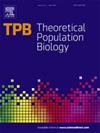Evolution between two competing macrophyte populations along a resource gradient leads to collapse in a bistable lake ecosystem
IF 1.3
4区 生物学
Q4 ECOLOGY
引用次数: 0
Abstract
While it is known that shallow lake ecosystems may experience abrupt shifts (ie tipping points) from a clear water state to a contrasting turbid alternative state as a result of eutrophication, the role of evolutionary processes and the impact of trait variation in this context remain largely unexplored. It is crucial to elucidate how eco-evolutionary feedbacks affect abrupt ecological transitions in shallow lakes and more in general in bistable ecosystems. These feedbacks can significantly alter the dynamics of aquatic plants competition, community structure, and species diversity, potentially affecting the existence of alternative states or either delay or expedite the thresholds at which these ecological shifts occur. In this paper, we explore the eco-evolutionary dynamics of submerged and floating macrophytes in a shallow lake ecosystem under asymmetric competition for nutrients and light along a gradient of nutrient diffusion. We use Adaptive Dynamics and a structured population model to analyze the evolution of the growth depth of the submerged and floating macrophytes populations, which influences their competitive ability for the two resources. We show how trait evolution can result in complex dynamics including evolutionary oscillations, extensive diversification and evolutionary suicide. Furthermore, we find that the co-evolution of the two competing populations plays a stabilizing role, but does not significantly alter the dynamics compared to when only one of the two populations is evolving. Overall, our study contributes to the understanding of the effects of evolution on the ecological dynamics of bistable ecosystems.
两个相互竞争的大型植物种群沿着资源梯度的进化导致双稳态湖泊生态系统的崩溃。
虽然众所周知,由于富营养化,浅湖生态系统可能会经历从清澈的水状态到对比浑浊的替代状态的突变(即引爆点),但在这种情况下,进化过程的作用和性状变异的影响在很大程度上仍未被探索。阐明生态进化反馈如何影响浅湖和双稳态生态系统的突然生态转变是至关重要的。这些反馈可以显著改变水生植物竞争、群落结构和物种多样性的动态,潜在地影响替代状态的存在,或延迟或加速这些生态转变发生的阈值。本文研究了浅湖生态系统中沉水植物和浮水植物在养分和光照不对称竞争下的生态进化动态。采用自适应动力学和结构种群模型,分析了沉水和浮水大型植物种群生长深度的演变及其对两种资源竞争能力的影响。我们展示了性状进化如何导致复杂的动力学,包括进化振荡、广泛多样化和进化自杀。此外,我们发现两个竞争种群的共同进化起着稳定作用,但与两个种群中只有一个进化时相比,这并没有显著改变动态。总的来说,我们的研究有助于理解进化对双稳态生态系统生态动力学的影响。
本文章由计算机程序翻译,如有差异,请以英文原文为准。
求助全文
约1分钟内获得全文
求助全文
来源期刊

Theoretical Population Biology
生物-进化生物学
CiteScore
2.50
自引率
14.30%
发文量
43
审稿时长
6-12 weeks
期刊介绍:
An interdisciplinary journal, Theoretical Population Biology presents articles on theoretical aspects of the biology of populations, particularly in the areas of demography, ecology, epidemiology, evolution, and genetics. Emphasis is on the development of mathematical theory and models that enhance the understanding of biological phenomena.
Articles highlight the motivation and significance of the work for advancing progress in biology, relying on a substantial mathematical effort to obtain biological insight. The journal also presents empirical results and computational and statistical methods directly impinging on theoretical problems in population biology.
 求助内容:
求助内容: 应助结果提醒方式:
应助结果提醒方式:


